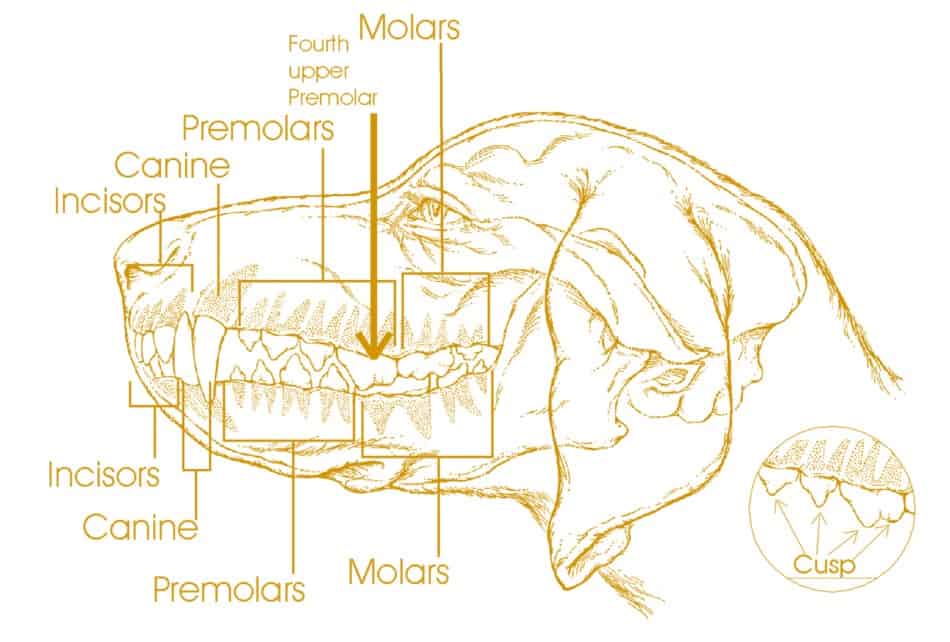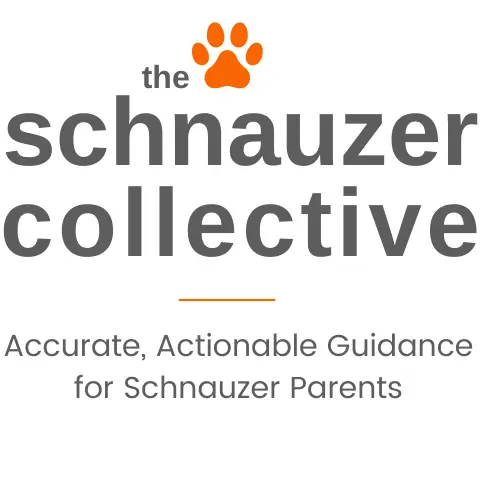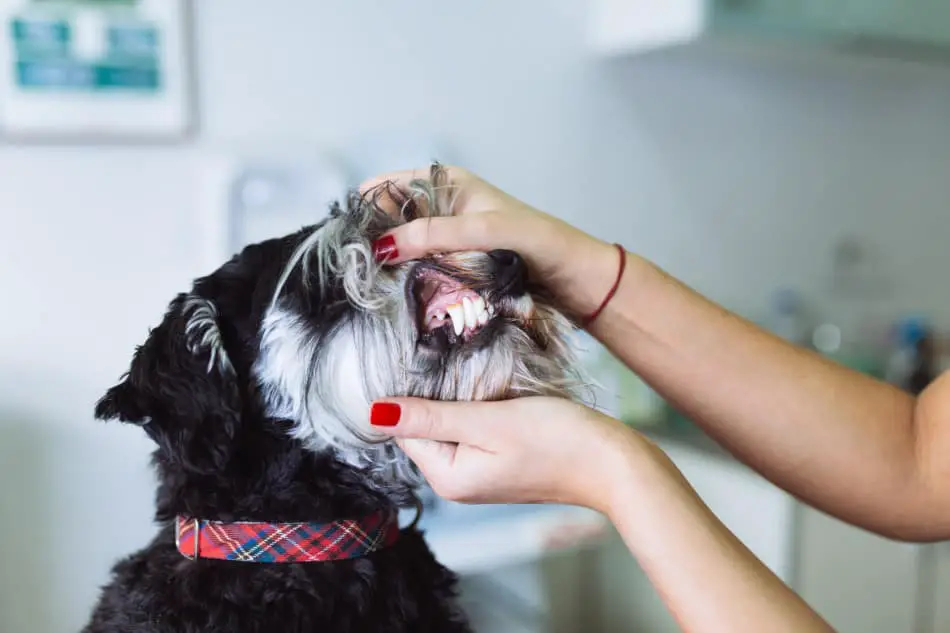Did you know that only 2% of all dog owners brush their dog’s teeth daily? While that is probably not surprising, it is discouraging…even alarming. Brushing your Schnauzer’s teeth regularly, even just 2-3 times per week, is critical to his health. I didn’t initially understand the importance of brushing our Livi’s teeth when we first brought her home. I was under the misconception that teeth cleaning treats and perhaps an enzymatic water additive would do the trick. Once I started noticing some build-up on Livi’s teeth, I visited her veterinarian, did some deep research, and got on track with teeth brushing. Here’s what I learned.
Do Schnauzers have bad teeth? Yes, all Schnauzer breeds have genetically bad teeth and are more susceptible to periodontal disease than other dog breeds. If you don’t brush their teeth, tartar and plaque will accumulate, leading to gingivitis and ultimately gum disease, tooth loss, and even organ damage.
According to the American Veterinary Dental Society, 80% of canines develop periodontal illness by the age of three. Without proper care, your Schnauzer’s gums will start breaking down due to periodontal disease, increasing the risks of harmful bacteria entering the bloodstream of your dog. Once the bacteria enter the bloodstream, your Schnauzer’s immune system will become compromised and may eventually cause diseases that attack his vital organs.
According to research, canines with poor dental hygiene are more prone to eye problems, joint problems, liver disease, kidney disease, and heart disease.
This article will cover how to inspect and brush your Schnauzer’s teeth, but first, let’s talk about why Schnauzers have bad teeth and take a comprehensive look at common Schnauzer dental problems.
Why Do Schnauzers Have Bad Teeth?
Unfortunately, each Schnauzer breed (Giant, Standard, and Miniature) are more likely to experience periodontal disease than other dog breeds.
As a general rule, purebred dogs, such as Schnauzers, tend to develop genetic health problems over time due to the inbreeding process. While responsible breeders will breed only for improvement of the breed, the inbreeding process naturally results in some genetic strengths along with a few genetic weaknesses. This holds true for Schnauzers.
Standard Schnauzers are the original Schnauzer breed and is the healthiest of the three purebred Schnauzer variations. Giant and Miniature Schnauzers were bred later in history and have genetic predispositions to a few more health problems.
All Schnauzer breeds, however, are prone to gum disease as a result of generations of breeding. Just knowing this fact will arm you with the information and motivation you need to pay extra attention to your Schnauzer’s dental hygiene.
What Are Common Dental Problems for Schnauzers?
If your Schnauzer is has bad breath or is showing some symptoms of developing dental problems, it’s time to see a veterinarian for an assessment.
Caring for your Schnauzer’s teeth is not a difficult thing, and you can save your pet from a lot of suffering and pain.
Before we look at the process of brushing your Schnauzer’s teeth, here are some of the common mouth problems which are brought about by poor dental health.
Bad breath
Bad breath, also known as halitosis, is usually one of the first signs that your dog is developing mouth problems. It is caused by odor-producing microbes of the gut or mouth. You should have your veterinarian examine your Schnauzer first to establish the underlying causes.
If the breath is sweet-smelling or fruity, it might be an indication of diabetes. If the breath is fouler, it could be a sign of kidney or liver disease. However, in most cases, you can cure bad breath by brushing his teeth daily and feeding him high-quality pet food.
Fractured or Chipped Teeth
Your Schnauzer can chip or fracture a tooth by simply chewing hard chew toys, bones, or other hard objects, and because dogs tend to hide the pain, the condition might go unnoticed for some time. Therefore, you should know the signs that indicate your pet friend is experiencing mouth pain.

Symptoms of fractured or chipped teeth:
- Avoiding hard foods
- Chewing food on one side
- Dropping foods when chewing
- Excessive drooling
- No interested in chew toys
- Odd behavioral changes, especially with regard to eating, brushing, etc.
- Pawing at his face or mouth area
- Grinding his teeth
- Swelling or tenderness
- Enlarged lymph nodes
Plaque
Plaque typically develops due to foods being left on the dog’s teeth for a long time. The microbes that reside in your Schnauzer’s mouth secrete acids that can destroy the tooth enamel over time. Plaque can also build up under the pet’s gum lines and, over time, destroy bone support to the teeth leading to tooth loss.
Generally, plaque accumulates every six hours, and brushing your pet’s teeth is the only effective method of removing it (aside from professional treatment). This is why many recommendations specifically suggest that you brush your Schnauzer’s teeth every day. Brushing his teeth shortly before bedtime is ideal because it allows the cleaning products to effectively work when there is no more eating or drinking through the night.
Tartar
When plaque is left on the teeth of a dog for too long, it starts to harden, creating a visible layer on the teeth. Tartar is typically the visible brown layer or the stains you can see on the enamel. If your Schnauzer has tartar accumulation, the best way to safely get rid of it is through professional dental cleaning process under anesthesia.
Gingivitis
This condition appears as some red inflammations on the gums, which are caused by the accumulation of plaque on the surface of the teeth and underneath the gum tissues. Plaque is that sticky coating which is made up of acid, food, saliva and bacteria. It constantly forms on the teeth’s surface, and when it hardens, it creates a substance known as dental tartar or calculus on the teeth.
Each of the common tooth and mouth problems listed above can lead to the ultimate and devastating issue of periodontal disease.
Let’s explore periodontal disease in depth.
What is Periodontal Disease in Schnauzers?
This condition is typically a bacterial infection that destroys the supporting bone and attachment fibers that hold the teeth of your dog in the mouth. When periodontal illness is left untreated for too long, it can cause tooth loss and also spread the infection throughout the dog’s body affecting its kidney, liver, heart, and the nervous system as well. The main culprit of periodontal illness is bacterial plaque. This condition can severely undermine the health of your Schnauzer.
Periodontal disease features a complex progression of problems as the tissue and bone is destroyed. This process leaves “periodontal pockets” around the teeth. As bacteria continues to build and the disease progresses, the deep pockets collect even more bacteria causing continued tissue and bone loss.
Signs of Periodontal Disease
If you are brushing and inspecting your Schnauzer’s teeth and mouth regularly, you will notice changes more readily and any problems should be minor.
However, if you are not in the habit of brushing his teeth, periodontal disease can develop silently over time. If you notice any of the symptoms below, please check your Schnauzer’s teeth and schedule a check-up with your veterinarian.

Symptoms of severe gum disease include:
- Bad breath
- Bleeding or red gums
- Bloody or “ropey” saliva
- Blood in his water bowl, chew toys, or bedding
- Sneezing or nasal discharge due to bone loss between the nasal and oral cavity
- Not wanting his head touched
- Loose teeth
- Chewing on one side of his mouth
- “Talking” or making noises when he eats or yawns
- Problems picking up food
- Bumps or lumps in his mouth
- A black line along his gum line. However, many Schnauzers will have black spots in their mouths that are simply normal and harmless pigmentation. Read my article Why Does My Schnauzer’s Mouth Have Black Spots (Top Reasons) for more information.
The Stages of Periodontal Disease and How to Treat
As the veterinary field grows and advances, canine research and practice supports better care for your Schnauzer. Even though you may not have planned to take your Schnauzer to the “dentist,” your veterinarian will serve as just that.
Being alert to any change in your Schnauzer’s breath, teeth, and gums is critical. Regular checkups with your veterinarian will also be key in preventing and addressing problems.
If your Schnauzer is developing any form of periodontal disease, it needs to be addressed. Treatment will require both an exam and X-rays to determine the severity and necessary treatment plan.
Generally speaking, your Schnauzer will be given anesthesia for any level of teeth cleaning or treatment.

Here are the essential stages and treatment options:
| Stage 1 | Mild inflammation or redness of the gums, but no periodontal pockets have developed between the gum and teeth. Requires cleaning both above and below the gum line and is a relatively mild, early, and treatable stage of disease. |
| Stage 2 | Periodontal pockets have developed between the gum and tooth, but there is not yet any significant tissue or bone loss. The gum tissue and tooth root require cleaning, rinsing, along with a treatment to help the gum reattach to the tooth root. |
| Stage 3 | The stage of full periodontal disease. The periodontal pockets have deepened to more than 5 millimeters in depth and have caused bone loss. Depending on your area and veterinarian, there may be treatment options available that are designed to grow new tissue and bone. |
| Stage 4 | Full periodontal disease has become more severe and bone loss is over 50%. The only available treatment is tooth extraction. |
Know Your Schnauzer’s Mouth: How Many Teeth Does He Have?
It’s is important that you know your Schnauzer’s mouth and become comfortable inspecting it regularly. Understanding what is normal and what is not normal when it comes to your Schnauzer’s teeth, gums, tongue, and mouth is your responsibility at a pet parent.

Your Schnauzer’s Baby Teeth
A Schnauzer pup is born with 28 baby teeth. They are called “deciduous” teeth, like human baby teeth, because they fall out just like the leaves on deciduous trees.
Your Schnauzer’s baby teeth will fall out when he is between 4-6 months, and will be replaced with permanent, adult teeth. Some breeder’s and new pup parents may choose to brush the baby teeth, but regular brushing can generally wait until adult teeth come in.
Your Schnauzer’s Adult Teeth
Once all adult teeth have come in, your Schnauzer will have a total of 42 teeth. Generally speaking, your Schnauzer will have 20 teeth on the top and 22 on the bottom.
Once the adult, permanent teeth have come in, it’s absolutely time to start a regular brushing routine. Recommendations range from brushing his teeth twice per DAY as humans do to brushing at least twice per week. You can work with your veterinarian to settle on an ideal schedule, but anything between 3 times per week to once per day should be acceptable.
How To Clean Your Schnauzer’s Teeth
Brushing your dog’s teeth is one of the most significant things you can do to prolong the pet’s life. Doing it every day will help prevent the accumulation of tartar and plaque, which might otherwise develop into periodontal disease.
You should start brushing your Schnauzer’s teeth daily when he a small puppy. That will assist in stimulating its gum lines and also help him become comfortable and accept the process of having regular dental cleanings.

Here is a step-by-step guide for cleaning your Schnauzer’s teeth.
1. Set a specific time of day
Choose some time during the day that works best for you, but it’s always a good idea to set a time of day when your dog is relaxed and calm. Whatever time you select, try, and keep it as part of your routine each day because cleaning dog teeth daily is the most effective to maintain good dental health. As mentioned above, bedtime is often an ideal time to brush your Schnauzer’s teeth for the day.
2. Choose a comfortable, consistent spot
Get a convenient location for both of you. For instance, you can have your dog lie on a couch or the bed. That way, you can easily clean one side of his mouth and then turn him over to brush the other side more easily.
3. Collect your brushing tools
Make sure you have everything ready before you begin brushing your schnauzer’s teeth. Apart from the toothbrush and toothpaste designed for canines, you can also have a washcloth to help you hold back his open mouth.
Note: Only use a canine-approved toothpaste! Canine toothpastes are formulated to be safe for dogs and swallowed without causing harm. Human toothpaste is toxic for your Schnauzer.
4. Inspect your Schnauzer’s teeth
Begin the cleaning process by giving your dog a good oral examination. Lift the lip of your Schnauzer and look at its teeth. Check for any signs of tartar, plaque, gum disease, or tooth decay.
5. Inspect your Schnauzer’s mouth
Place your thumbs gently on either side of the Schnauzer’s muzzle and lightly stoke downward. Check if there any abnormalities or lumps. Also, check the gum lines of your dog. The gums should not be swollen and must be pink in color, not red.
6. Begin brushing the teeth
- Put a small amount of gel or toothpaste on the finger brush or toothbrush. Next, pull the corner of your dog’s mouth backward using your thumb to lower and press down the bottom lip and your index finger to raise the top lip.
- Start brushing at the back of its mouth and begin with gentle back-and-forth strokes. Avoid applying too much pressure because it can cause damages to the gum line, making your Schnauzer squirm to get free.
- Utilize light pressure at all times because you want your pet to accept the cleaning process. Clean the upper and low teeth, spending 30-40 seconds on each section.
- If your Schnauzer pulls away in pain or his gums bleed at all during the brushing process, make an appointment with your veterinarian as soon as possible.
Bonus Tips For Keeping Your Schnauzer’s Teeth Clean
Just like human teeth, Schnauzers’ teeth require regular cleanings to prevent tartar and plaque build-up. There are many ways you can use to help keep the teeth of your schnauzer clean, including:

- Giving him raw bones that help to reduce tartar
- Give him carrots and apples as treats
- Using tartar-reducing additives for his water
- Getting him in a chewing habit using chewy toys designed explicitly for teeth cleaning
- Consider using a homeopathic remedy called Fragaria
- Consider brushing his teeth with coconut oil which is safe, tastes good, and has antibacterial properties
- Consider giving appropriate doses of cinnamon, which has antibacterial properties.
A Note about Cinnamon:
Be sure to use Ceylon Cinnamon derived from the Ceylon Cinnamon tree. This variety of cinnamon has lower levels of courmarin which is a chemical compound found in many plants and can cause some health risks for your Schnauzer. Do not purchase Chinese Cinnamon Tree because it has much higher levels of courmarin.
Having stated that caution, adding a dose of cinnamon to your Schnauzer’s diet could be a positive move. Cinnamon adds some interesting flavor to his food, and more importantly, has the power to stop bacteria growth and contains anti-inflammatory properties.
The dosing for your Schnauzer’s weight is key. Start him off with the smallest dose and increase in increments until he is at the recommended amount.
The doses below daily dosages for dry powder Ceylon Cinnamon:
1-10 lbs: a small pinch up to 1/8 teaspoon
10-20 lbs: to ¼ teaspoon
20-50 lbs: ¼ to 1 teaspoon
50-100 lbs: 1 to 2 teaspoons
Over 100 lbs: 2 teaspoons to 1 tablespoon
Your Schnauzer’s dental hygiene is a key element of his overall health. Regular brushing along with consistent inspection and at least annual veterinarian check-ups will help him live a longer, healthier, more comfortable life.
And finally, from one pet parent to another, discover my all-time favorite resources designed to cover your every Schnauzer need. I’ve done the legwork for you so you can spend more time with the people and fur friends in your life.
A portion of all profit earned on this site is donated to Pet Partners
whose mission is to improve human health and
well-being through the human-animal bond.
They train and register pets to become therapy animals,
and have local chapters in many states.

